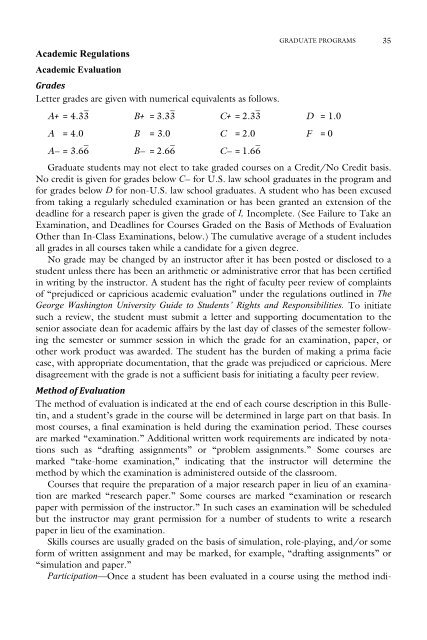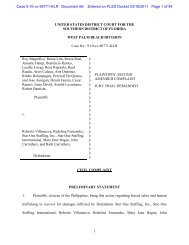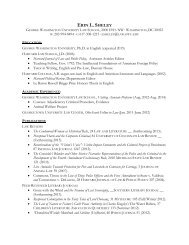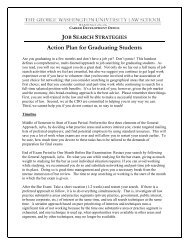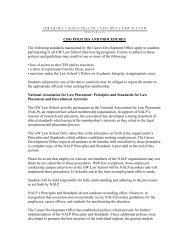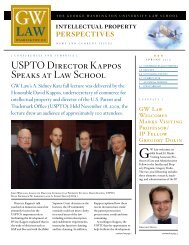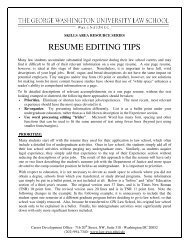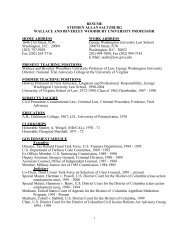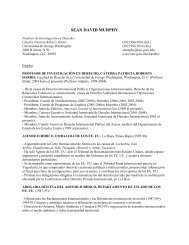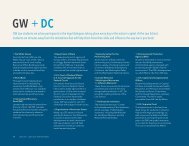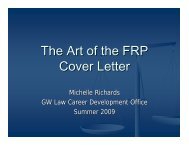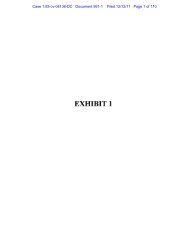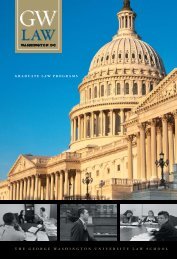The Bulletin - George Washington University Law School
The Bulletin - George Washington University Law School
The Bulletin - George Washington University Law School
- No tags were found...
Create successful ePaper yourself
Turn your PDF publications into a flip-book with our unique Google optimized e-Paper software.
Academic RegulationsAcademic EvaluationGradesLetter grades are given with numerical equivalents as follows.GRADUATE PROGRAMS 35A+ = 4.33 – B+ = 3.33 – C+ = 2.33 – D = 1.0A = 4.0 B = 3.0 C = 2.0 F = 0A = 3.66 – B = 2.66 – C = 1.66 –Graduate students may not elect to take graded courses on a Credit/No Credit basis.No credit is given for grades below C for U.S. law school graduates in the program andfor grades below D for non-U.S. law school graduates. A student who has been excusedfrom taking a regularly scheduled examination or has been granted an extension of thedeadline for a research paper is given the grade of I, Incomplete. (See Failure to Take anExamination, and Deadlines for Courses Graded on the Basis of Methods of EvaluationOther than In-Class Examinations, below.) <strong>The</strong> cumulative average of a student includesall grades in all courses taken while a candidate for a given degree.No grade may be changed by an instructor after it has been posted or disclosed to astudent unless there has been an arithmetic or administrative error that has been certifiedin writing by the instructor. A student has the right of faculty peer review of complaintsof “prejudiced or capricious academic evaluation” under the regulations outlined in <strong>The</strong><strong>George</strong> <strong>Washington</strong> <strong>University</strong> Guide to Students’ Rights and Responsibilities. To initiatesuch a review, the student must submit a letter and supporting documentation to thesenior associate dean for academic affairs by the last day of classes of the semester followingthe semester or summer session in which the grade for an examination, paper, orother work product was awarded. <strong>The</strong> student has the burden of making a prima faciecase, with appropriate documentation, that the grade was prejudiced or capricious. Meredisagreement with the grade is not a sufficient basis for initiating a faculty peer review.Method of Evaluation<strong>The</strong> method of evaluation is indicated at the end of each course description in this <strong>Bulletin</strong>,and a student’s grade in the course will be determined in large part on that basis. Inmost courses, a final examination is held during the examination period. <strong>The</strong>se coursesare marked “examination.” Additional written work requirements are indicated by notationssuch as “drafting assignments” or “problem assignments.” Some courses aremarked “take-home examination,” indicating that the instructor will determine themethod by which the examination is administered outside of the classroom.Courses that require the preparation of a major research paper in lieu of an examinationare marked “research paper.” Some courses are marked “examination or researchpaper with permission of the instructor.” In such cases an examination will be scheduledbut the instructor may grant permission for a number of students to write a researchpaper in lieu of the examination.Skills courses are usually graded on the basis of simulation, role-playing, and/or someform of written assignment and may be marked, for example, “drafting assignments” or“simulation and paper.”Participation—Once a student has been evaluated in a course using the method indi-


